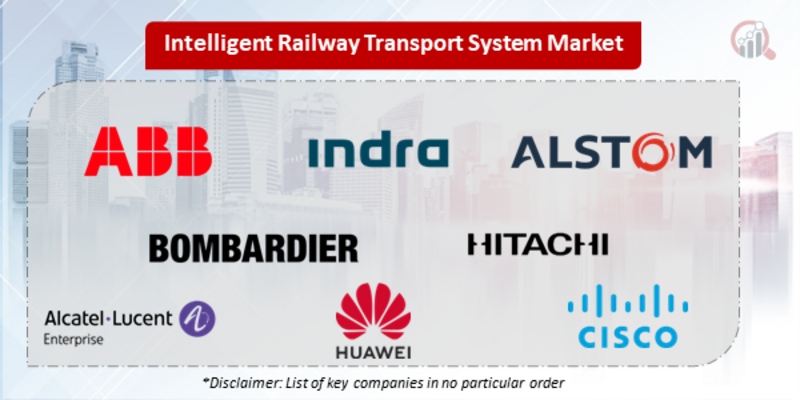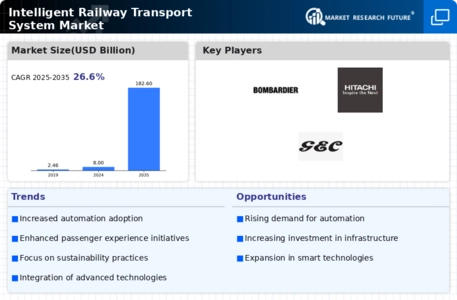Top Industry Leaders in the Intelligent Railway Transport System Market

Competitive Landscape of the Intelligent Railway Transport System (IRTS) Market
The Intelligent Railway Transport System (IRTS) market is experiencing a surge, propelled by the relentless pursuit of efficiency, safety, and sustainability in the global rail sector. This burgeoning landscape fosters a dynamic competitive environment, where established players and emerging start-ups vie for market share through diverse strategies and innovations. Understanding the key players, their adopted strategies, and the factors influencing their success is crucial for navigating this complex ecosystem.
Some of the Intelligent Railway Transport System (IRTS) companies listed below:
- ABB Group
- Indra Sistemas, S.A.
- Alstom S.A.
- Alcatel-Lucent S.A.
- Bombardier Inc.
- Huawei Technologies Co. Ltd.
- Hitachi, Ltd.
- Cisco Systems, Inc.
- Siemens AG
- International Business Machines Corporation
- General Electric Company
- Ansaldo Signalling and Transportation Systems
Market Share Analysis: A Multi-Dimensional Puzzle
Assessing market share in the IRTS market demands a multi-faceted approach. While revenue figures offer a basic gauge, a comprehensive understanding requires considering additional dimensions:
- Technology Scope: The market encompasses diverse technologies like communication systems, train control systems, and passenger information systems. Analyzing market share by technology segment reveals the strengths and weaknesses of different players.
- Geographic Reach: The IRTS market is geographically diverse, with varying adoption rates and growth trajectories across continents. Identifying regional leaders and understanding their strategies provides valuable insights.
- Project Portfolio: Some players focus on large-scale national projects, while others cater to smaller regional initiatives. Analyzing the types and sizes of projects undertaken by different players paints a clearer picture of their market footprint.
- Integration Capabilities: Successful IRTS implementation necessitates seamless integration between various technologies and existing infrastructure. Players with strong integration expertise hold a significant advantage.
Adopted Strategies: Fueling the Engine of Growth
To carve a niche in this competitive landscape, leading players are deploying a range of strategies:
- Strategic Partnerships and Collaborations: Recognizing the complexity of IRTS implementation, established players are forging partnerships with technology providers, communication giants, and infrastructure companies. This collaborative approach facilitates knowledge sharing, technology transfer, and risk mitigation.
- Focus on Innovation: Continuous R&D is paramount in this rapidly evolving field. Players are investing heavily in next-generation technologies like artificial intelligence, big data analytics, and cybersecurity solutions to differentiate themselves and address emerging market needs.
- Localization and Customization: Adapting solutions to the specific needs and regulations of different regions is crucial for success. Players are tailoring their offerings to cater to local infrastructure, operational requirements, and regulatory frameworks.
- Data-Driven Decision Making: Leveraging data analytics to optimize operational efficiency, predict maintenance needs, and personalize passenger experiences is becoming increasingly important. Players are investing in data-centric solutions to improve their service offerings and gain a competitive edge.
New and Emerging Players: Disrupting the Status Quo
While established giants like Siemens, Alstom, and Bombardier hold significant market share, a wave of new and emerging players is challenging the status quo. These agile startups, often specializing in specific niche technologies, are bringing fresh perspectives and innovative solutions to the market. Some key areas of innovation include:
- Predictive Maintenance: Leveraging AI and sensor technology to predict equipment failures and optimize maintenance schedules.
- Cybersecurity Solutions: Addressing the growing threat of cyberattacks on critical railway infrastructure.
- Hyperloop and Maglev Technologies: Developing next-generation high-speed transportation solutions.
- Autonomous Train Operations: Implementing automated train control systems for increased efficiency and safety.
Latest Company Updates:
September 2023- Chennai Metro Rail has introduced WhatsApp e-tickets. Two months after initiating National Common Mobility Cards (NCMC), Chennai Metro Rail Limited (CMRL) will begin providing e-tickets through WhatsApp. A phone number will be shown at stations where riders can send a message to start the process of getting their tickets. The system will offer multiple payment choices, including debit & credit cards and also Google Pay.
September 2023- In a pioneering effort to boost passenger safety and enforcement across its vast network, Central Railways has unveiled plans to install a massive 6,122 cameras at 364 stations. This ambitious endeavor, partially funded by the Nirbhaya fund, marks a major step in strengthening security within India's rail infrastructure. The key goals of these facial recognition cameras are multi-fold. Firstly, they will act as a powerful deterrent to potential wrongdoers, effectively curbing criminal activity. Secondly, they will assist in monitoring and enforcing adherence to railway rules, ensuring a more secure travel experience for passengers. These cutting-edge cameras come equipped with various advanced capabilities, such as Video Analytics and a Video Management System.
July 2023- IntelliTrans has teamed up with Nexxiot to supply Internet of Things sensor information. This partnership will give IntelliTrans' freight train transportation management systems real-time data on individual assets. By combining IntelliTrans' industry knowledge and skills with live data from Nexxiot's sensors, the rail sector now has something unprecedented - solutions to real-world challenges. With IntelliTrans' database and data collection abilities, their technology is capable of more than just monitoring assets; it can reduce risks, enhance safety, and satisfy customers.








